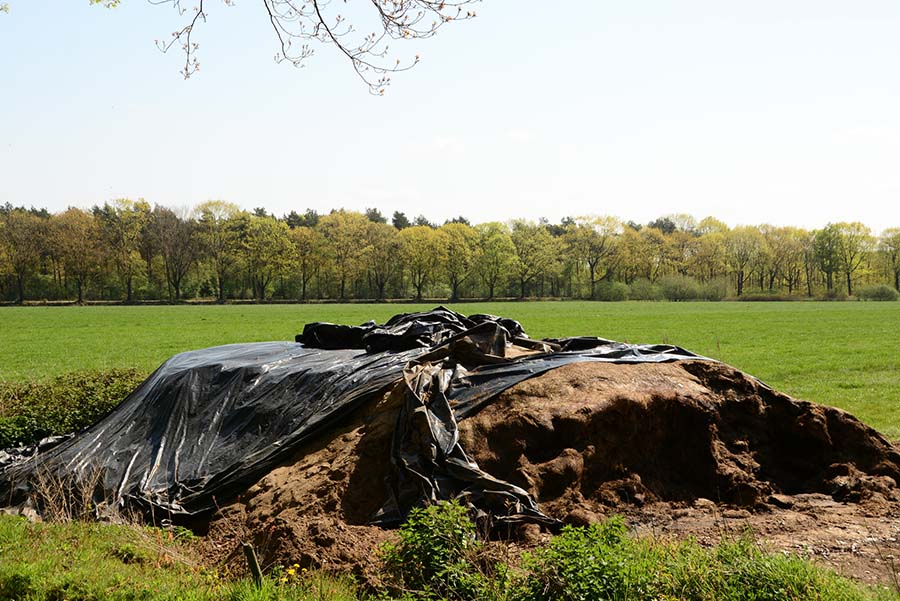Even with the best quality covers and careful management, problems can arise that compromise their effectiveness and put your silage at risk. Leaks, tears, and poor sealing allow oxygen and moisture to infiltrate your silage, creating a breeding ground for spoilage microorganisms and diminishing the quality of your feed. This article reviews practical tips to identify, repair, and prevent common problems like leaks, tears, and sealing issues.
Issue 1: Leaks and Tears
Leaks and tears in your silage cover are like cracks in a dam – they can lead to a gradual but significant erosion of your feed quality. Even minor breaches can allow oxygen and moisture to infiltrate your silage, creating ideal conditions for spoilage microorganisms to thrive and degrade your valuable feed.
Identifying the Culprits
Leaks and tears can happen for a variety of reasons, and the first step in addressing them is identifying their source. Here are some of the usual suspects:
Sharp Objects
Sharp objects like sticks, rocks, or bits of metal can poke holes in your cover and create significant leaks. They might get caught in the cover during deployment or may be present in the fodder itself.
Animal Activity
Birds, rodents, and even your livestock can cause damage to covers. Those critters can wreak havoc, whether it’s pecking, clawing, or just plain walking around.
Machinery
Tractors, loaders, or other machinery used around the silage storage area can accidentally snag or tear the cover.
Wind Damage
Strong winds can whip your cover around, causing it to flap and tear, especially if it’s not adequately secured.
Seam Weakness
Over time, the seams of the cover can weaken or separate, providing a direct entry for moisture and microbes.
UV Degradation
Even the best cover materials will eventually degrade from sun exposure, becoming brittle and prone to cracks and tears.
Patching Things Up
Once you’ve identified a leak or tear, it’s time to patch it up before the damage or spoilage gets worse. Here’s how:
Patches
If there are small tears or punctures, use patches made from the same material as the cover or a compatible repair tape for reliable adhesion.
The patch should be large enough to cover the damaged area completely, with a few inches of overlap around the edges for a more robust repair. Thoroughly clean the area around the tear to remove dirt, debris, or loose silage, and allow it to dry completely.
Apply the patch carefully, eliminating wrinkles or air bubbles as you go. Press firmly to create a strong bond. Consider reinforcing the patch with additional tape or sealant around the edges if the tear is large or in a high-stress area.
Seam Repair
If you find a seam that has separated, use a strong adhesive or sealant specifically designed for the cover material to reseal the seam. Clean and dry the area thoroughly before applying the sealant.
Heat welding can be used on certain types of materials to repair seams or tears. This method uses specialized equipment to melt and fuse the edges of the cover. However, heat welding requires specific tools and some training, so it may be best to consult a professional cover repair service for this method.
Professional Repair
Consider contacting a professional cover repair service for extensive damage or complex repairs. They have the expertise and tools to handle more challenging jobs. They can also advise you if a replacement would be more cost-effective than repair.
Issue 2: Poor Sealing: The Silent Thief of Silage Quality
A poorly sealed silage cover is like a leaky roof – it may not seem like a big deal at first, but those small gaps can lead to significant damage down the line. In the case of silage, poor sealing allows oxygen to infiltrate the pile, disrupting fermentation, encouraging spoilage, and ultimately ruining your feed.
The Price of a Poor Seal
Even small gaps or air pockets in your silage cover can have detrimental effects:
Aerobic Spoilage
Oxygen is the enemy of good silage. When it gets into the pile, harmful microorganisms, like yeasts and molds, can thrive. These troublemakers break down valuable nutrients, create off-flavors, and generate heat, all of which contribute to spoilage and reduce feed quality.
Nutrient Loss
Essential nutrients, such as sugars, proteins, and vitamins, are the building blocks of healthy silage. A poor seal allows them to break down, leaving your silage nutritionally lacking.
Unappetizing Feed
Spoiled silage often develops unpleasant odors and flavors, making it less appealing to livestock. Would you want to eat something that smells spoiled? Neither do your animals!
Toxic Toxins
Some molds that thrive in the presence of oxygen produce mycotoxins, harmful substances that can cause health problems in livestock.
Economic Losses
Spoilage means wasted feed, which means you have to replace it. This adds to your operational costs and reduces the overall efficiency of your operation.
Spotting a Poor Seal
Detecting a poor seal requires a keen eye and attention to detail. Look for these telltale signs:
Gaps: Examine the cover for visible gaps or openings around the edges, especially where it meets the silo walls.
Air Pockets: Look for areas where the cover is billowing or bulging, which indicates there are trapped air pockets beneath.
Weight Check: Make sure the weights used to secure the cover are correctly distributed and haven’t shifted or blown away. Inadequate weighting could allow the seal to fail.
Damage Detection: Inspect the cover for tears, punctures, or seam separation that could compromise the seal.
Sniff Test: If you detect any unusual or unpleasant odors coming from the silage, it could be a sign of spoilage due to a poor seal. Follow your nose to see where it leads you.
Establishing and Maintaining a Proper Seal
Your fodder needs an effective seal to create high quality silage. Here are some points to keep in mind:
Smooth Silo Walls: Make sure the walls of your silo are smooth and free from bumps or irregularities that could prevent the cover from lying flat along the edges.
Careful Cover Application: Deploy the cover carefully so that it lies smooth and wrinkle-free. Multiple sheets should be overlapped enough to eliminate gaps.
Weights: Use enough weights to keep the cover in place without shifting and prevent air pockets from forming. Distribute the weight evenly across the cover.
Edge Sealing: Pay close attention to sealing the edges of the cover where it meets the silo walls. Use sealant, sandbags, or other materials to create a tight seal around the perimeter.
Regular Checkups: Regularly inspect the cover for signs of damage or poor sealing, and, as always, address issues right away.
Wrapping Up
For more information on topics like choosing the right cover, mastering weighting techniques, and exploring the latest advancements in silage cover technology, check out the other articles in this series.




